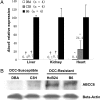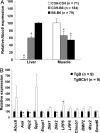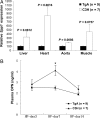Identification of Abcc6 as the major causal gene for dystrophic cardiac calcification in mice through integrative genomics
- PMID: 17360558
- PMCID: PMC1838635
- DOI: 10.1073/pnas.0607620104
Identification of Abcc6 as the major causal gene for dystrophic cardiac calcification in mice through integrative genomics
Abstract
The genetic factors contributing to the complex disorder of myocardial calcification are largely unknown. Using a mouse model, we fine-mapped the major locus (Dyscalc1) contributing to the dystrophic cardiac calcification (DCC) to an 840-kb interval containing 38 genes. We then identified the causal gene by using an approach integrating genetic segregation and expression array analyses to identify, on a global scale, cis-acting DNA variations that perturb gene expression. By studying two intercrosses, in which the DCC trait segregates, a single candidate gene (encoding the ATP-binding cassette transporter ABCC6) was identified. Transgenic complementation confirmed Abcc6 as the underlying causal gene for Dyscalc1. We demonstrate that in the cross, the expression of Abcc6 is highly correlated with the local mineralization regulatory system and the BMP2-Wnt signaling pathway known to be involved in the systemic regulation of calcification, suggesting potential pathways for the action of Abcc6 in DCC. Our results demonstrate the power of the integrative genomics in discovering causal genes and pathways underlying complex traits.
Conflict of interest statement
The authors declare no conflict of interest.
Figures




References
-
- Brean HP, Marks JH, Sosman MC, Schlesinger MJ. Radiology. 1950;54:33–42. - PubMed
-
- Brunnert SR. Lab Anim Science. 1997;47:11–18. - PubMed
-
- Van den Broek FA, Beynen AC. Lab Anim. 1998;32:483–491. - PubMed
-
- Korff S, Riechert N, Schoensiegel F, Weichenhan D, Autschbach F, Katus HA, Ivandic BT. Virchows Arch. 2005;448:630–638. - PubMed
-
- Van den Broek FA, Bakker R, den Bieman M, Fielmich-Bouwman AX, Lemmens AG, van Lith HA, Nissen I, Ritskes-Hoitinga JM, van Tintelen G, van Zutphen LF. Biochem Biophy Res Commun. 1998;253:204–208. - PubMed
Publication types
MeSH terms
Substances
Grants and funding
LinkOut - more resources
Full Text Sources
Medical
Molecular Biology Databases

